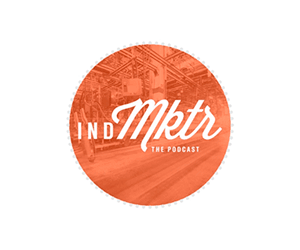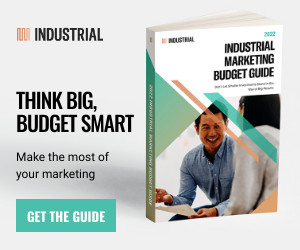Without a digital marketing strategy, you may not be getting the ROI you’re looking for from your marketing efforts. Like any business, manufacturing has quite a few peculiarities that make it unique. However, a business is still a business. It has a product or service that it makes or provides, and their customers that have problems that need solving.
So, despite all the things that make manufacturing unique, the question remains the same: How do we put the customers and our products together?
The answer, of course, is through clever, strategic marketing. And, with a digital marketing strategy, you can do so faster, with less effort, and with a bigger ROI than you could ever achieve with traditional marketing.
Don’t believe it? Well, consider the fact that a lowly pay-per-click (PPC) ad can generate a 200% ROI. How much do you think you’ll get back when you combine PPC with multiple digital marketing channels?
However, none of this will happen unless you know what you’re doing. But by the time you’re done with our five quick steps, you’ll be an expert at digital marketing strategy.
Form a Plan for Your Digital Marketing Strategy
The first step to creating a successful, digital marketing strategy is, of course, having a bulletproof plan.
Now, there are several steps that need to be completed before you have a comprehensive marketing plan, but the first is, obviously, research.
Start your research at home. take a look at your previous marketing campaigns, and identify what worked and what didn’t. By identifying successful strategies, you’ll be able to modify and reuse those strategies in your future marketing efforts to great effect.
But what if you haven’t had any marketing campaigns from which to draw strategies? What if this is your first campaign ever? Then, look to your peers and competitors. Analyze your competition, and see why their products are selling, and reverse-engineer their strategies. You should not outright copy their strategies but let them be your guide and adapt them to work with your particular brand.
Now, one of the most important things about forming a plan is identifying the core values of your business. What is it you’re trying to do? What are you selling? What problems are you trying to solve?
By identifying those core values, you’ll find out what to focus on in your marketing campaign. These core values are what you’ll be putting forward the most aggressively, as they’ll serve as your hook when attracting new leads.
Finally, no good plan can exist without a proper timeline. Oftentimes, hitting the market with your ads at just the right time is as important as the message they’re carrying, and a proper timeline will help you plan out those crucial moments and stay on schedule throughout your campaign.
Identify Your Clients’ Pain Points
One of the crucial steps toward creating a powerful digital marketing strategy is identifying your clients’ pain points. What we mean by this is to find out what your clients need; what they are having trouble with and how you can help them alleviate those troubles.
By identifying these key pain points, you can then focus your marketing efforts toward addressing those pain points. You can do this directly by creating ads that promote possible solutions or content (blog posts, videos, social media posts) that are directed toward you as the company that has all the solutions.
This is also where SharePoint consulting firms can be of great use to you. SharePoint is a CRM built to be integrated with Microsoft Office, and it can be a great tool for analyzing your customer base and helping identify those pain points we’re talking about.
Create Content for Each Stage of the Marketing Funnel
Did you know that 95% of the companies worldwide create top-of-funnel (TOFU) content, yet only 86% do so for the middle of the funnel? Even worse, only 75% create content for the bottom of the funnel, despite this being the crucial turning point where a lead becomes a customer.
Creating content and spreading it equally for all stages of the funnel can be crucial for the steady trickle of leads converting to customers. If your content strategy wows people at the beginning but fails to follow through, you’ll often see people just jumping ship, bouncing around and turning to your competitors.
Consider Several Content Options
Content is the absolute king when it comes to digital marketing. This is further reinforced by the fact that more than 90% of B2B and 86% of B2C companies use content marketing as their primary marketing strategy.
However, content appears in many shapes and forms. Here are some examples.
Include Blog Content
Blogs are by far the most popular and the most prolific content form. Blog content is relatively easy to create, don’t cost too much, yet are almost essential in garnering interest among customers, and are the best way a customer can become informed about your business and your products.
As such, blogs are ideal TOFU hooks, but are also useful in the middle and bottom of the funnel because they can provide extra information to help a customer make a decision.
Use Video to Engage
Video content has been slowly gaining popularity, even seeking to outpace blog posts in terms of efficiency, ROI and conversions. The reason behind this is that video content is very easily digestible. People prefer watching content and having the content being spoken to them rather than reading. Furthermore, with many social media platforms pushing short-form video content, video has become an ideal tool for reaching a wide audience quickly.
However, video content comes with one caveat: it can be quite expensive to produce. You will require a lot more equipment, talent, time and general know-how in order to produce one video than you’ll need to produce one blog post. Of course, there is always the option of issuing a video production RFP and allowing the contractors to make your life easier. But that comes with the burden of additional costs. That said, video and blog posts are quite interchangeable, and what was a good video can become a blog post, and vice versa.
Email Is Key to Your Digital Marketing Strategy
Believe it or not, email marketing is one of the strongest forms of marketing to date. In fact, 89% of all marketers use it as their primary lead-generation channel. Among B2B marketers, this number is even higher, at 93%.
The reason behind this is that email marketing is really easy to set up and launch. Emails can be used throughout the funnel to hook new leads, inform them, and keep them in the loop once they convert to customers.
Email is one of the most popular ways most companies promote their sales and deals. Emails are also used to promote a variety of other events (such as seminars and webinars) that are designed to keep prospects, leads and customers interested in what the company has to say.
In fact, email marketing is becoming an even more powerful tool through the use of automation. Automation technology has become quite advanced in recent years, and email lends itself perfectly to being automated.
With new AI technologies, email marketing campaigns are getting even easier to launch, while the emails themselves are getting more and more personalized, leading to better responses from the recipients.
Get More ROI With PPC Ads
As I noted earlier, PPC ads have an insane ROI while being cheap to create and easy to set up. That said, most people don’t like ads. However, PPC ads are so deeply integrated into Google that most people won’t even notice they’re clicking on an ad, making PPCs very digestible for users and not too intrusive.
As further testimony to the power and usefulness of PPC ads, consider this: PPC ads have a 50% greater conversion rate than organic ads. On top of that, PPC ads increase your brand awareness by 80%, making them almost invaluable for any company looking to both hook new leads, as well as convert existing ones.
Furthermore, PPC ads are instrumental in creating a prominent brand image and presence online, and can help push your website to the forefront of SERPs (Search Engine Result Pages).
Speak Through Customer Testimonials
Customers trust other customers a lot more than they do brands. This is why many companies like to use customer testimonials as a way to prove that they’re trustworthy and that their products/services are quality and useful to the customer. Customer testimonials are even more prominent among B2B, making it one of the best ways to promote your manufacturing business.
In B2B, business-client bonds are much stronger than in B2C, and the relationships formed last much longer. If you manage to have one client vouch for you, then you have a much better chance of bringing another client to the fold than if you had no testimonials.
Include Social Media Posts in Your Digital Marketing Strategy
Finally, social media posts are one of the most prominent and widely used forms of content among marketers and brands everywhere.
The thing about social media is that it helps form a more personal connection between a brand and a customer. The bond formed there is much more amicable than a simple transaction-based bond that companies have formed in the past. With social media, the brand isn’t just defined by its product but also by the amicability of its interactions with the customers, its customer service, and its overall image.
Measure and Revise
Finally, the last step toward creating the ultimate digital marketing strategy is to measure your progress and revise it if necessary. There are many ways you can measure your success and track your progress. Each of these ways will provide you with valuable insight into what’s working for you, where you are getting the most leads, and the reason those leads are converting. Measuring results also shows you where you’re losing people, as well as identifying bottlenecks.
With such insights, you will now have much better control over your digital marketing campaigns and will be able to revise your strategies on the fly, adjusting them as necessary to get the best results.
Ready to Begin Your Digital Marketing Strategy?
And, there you have it, five crucial tips on how to form a digital marketing strategy for a manufacturing business.
As we said in the beginning, no matter what kind of business you’re running, getting your product into the hands of the customers is your ultimate goal, and digital marketing provides the means to do it.
By following these steps, you can create a comprehensive strategy that will propel your business to new heights, as well as help you adapt your strategies in the future as new techniques and technologies emerge.




